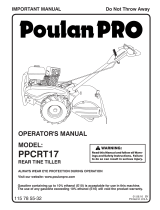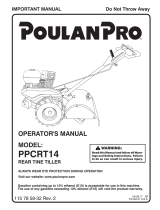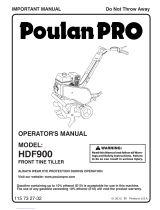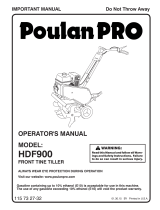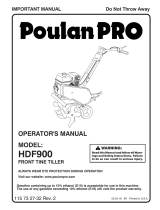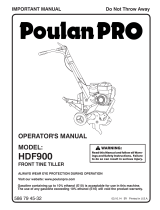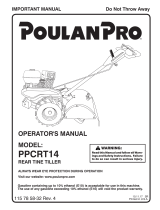Page is loading ...

Gasoline containing up to 10% ethanol (E10) is acceptable for use in this machine.
The use of any gasoline exceeding 10% ethanol (E10) will void the product warranty.
OPERATOR'S MANUAL
MODEL:
PPCRT14
REAR TINE TILLER
ALWAYS WEAR EYE PROTECTION DURING OPERATION
Visit our website: www.poulanpro.com
WARNING:
Read this Man u al and follow all Warn-
ings and Safety Instructions. Fail ure
to do so can re sult in serious in ju ry.
IMPORTANT MANUAL Do Not Throw Away
12.15.15 BY
115 78 58-32 Printed in U.S.A.

2
• Keep children and pets away.
• Do not overload the machine capacity by attempting
to till too deep at too fast a rate.
• Never operate the machine at high speeds on slippery
surfaces. Look behind and use care when backing.
• Never allow bystanders near the unit.
• Use only attachments and accessories approved by
the manufacturer of the tiller.
• Never operate the tiller without good visibility or light.
• Be careful when tilling in hard ground. The tines may
catch in the ground and propel the tiller forward. If this
occurs, let go of the handlebars and do not restrain
the machine.
MAINTENANCE AND STORAGE
• Keep machine, attachments, and accessories in safe
work ing condition.
• Check shear pins, engine mounting bolts, and other
bolts at frequent intervals for proper tightness to be
sure the equip ment is in safe working condition.
• Never store the machine with fuel in the fuel tank inside
a building where ignition sources are present, such
as hot water and space heaters, clothes dryers, and
the like. Allow the engine to cool before storing in any
enclosure.
• Always refer to the operator’s guide instructions for
im por tant details if the tiller is to be stored for an ex-
tended period.
- IMPORTANT -
CAUTIONS, IMPORTANTS, AND NOTES ARE A MEANS OF
ATTRACTING ATTENTION TO IMPORTANT OR CRIT I CAL
IN FOR MA TION IN THIS MANUAL.
IMPORTANT: USED TO ALERT YOU THAT THERE IS A
POS SI BIL I TY OF DAM AG ING THIS EQUIP MENT.
NOTE: Gives essential information that will aid you to bet-
ter understand, incorporate, or execute a particular set of
instructions.
Look for this symbol to point out im-
por tant safety precautions. It means
CAUTION!!! BE COME ALERT!!! YOUR
SAFE TY IS INVOLVED.
CAUTION: Always disconnect spark
plug wire and place wire where it can-
not contact spark plug in order to pre-
vent ac ci den tal starting when setting
up, trans port ing, adjusting or making
re pairs.
SAFETY RULES
Safe Operation Practices for Walk-Behind Powered Ro ta ry Tillers
TRAINING
• Read the Owner’s Manual care ful ly. Be thor ough ly
fa mil iar with the controls and the proper use of the
equip ment. Know how to stop the unit and disengage
the controls quickly.
• Never allow children to operate the equipment. Never
allow adults to op er ate the equipment without proper
instruction.
• Keep the area of operation clear of all persons, par-
tic u lar ly small children, and pets.
PREPARATION
• Thoroughly inspect the area where the equipment is
to be used and remove all foreign objects.
• Disengage all clutches and shift into neutral before
starting the engine (mo tor).
• Do not operate the equipment with out wearing ad-
e quate outer gar ments. Wear footwear that will im prove
footing on slippery surfaces.
• Handle fuel with care; it is highly flammable.
• Use an approved fuel container.
• Never add fuel to a running engine or hot engine.
• Fill fuel tank outdoors with extreme care. Never fill fuel
tank indoors.
• Replace gasoline cap securely and clean up spilled
fuel before restarting.
• Use extension cords and receptacles as specified by
the manufacturer for all units with electric drive motors
or electric starting motors.
• Never attempt to make any adjustments while the
engine (motor) is running (except where specifically
rec om mend ed by manufacturer).
OPERATION
• Do not put hands or feet near or under rotating parts.
• Exercise extreme caution when op er at ing on or cross-
ing gravel drives, walks, or roads. Stay alert for hidden
hazards or traffic. Do not carry pas sen gers.
• After striking a foreign object, stop the engine (motor),
remove the wire from the spark plug, thoroughly in spect
the tiller for any damage, and repair the damage before
restarting and op er at ing the tiller.
• Exercise caution to avoid slipping or falling.
• If the unit should start to vibrate ab nor mal ly, stop the
engine (motor) and check immediately for the cause.
Vi bra tion is generally a warning of trouble.
• Stop the engine (motor) when leaving the operating
position.
• Take all possible precautions when leav ing the ma chine
unattended. Disengage the tines, shift into neutral,
and stop the engine.
• Before cleaning, repairing, or inspecting, shut off
the engine and make certain all moving parts have
stopped. Disconnect the spark plug wire, and keep the
wire away from the plug to prevent accidental starting.
Disconnect the cord on electric motors.
• Do not run the engine indoors; exhaust fumes are
dangerous.
• Never operate the tiller without proper guards, plates,
or other safety protective devices in place.
WARNING
The engine exhaust from this product con tains
chem i cals known to the State of Cal i for nia to
cause cancer, birth defects, or other repro-
ductive harm.

3
CONGRATULATIONS on your purchase of a new tiller. It
has been designed, en gi neered and manu fac tured to give
you the best pos sible de penda bil ity and per form ance.
Should you experience any prob lems you can not easily
remedy, please contact your nearest authorized service
center. We have com pe tent, well-trained tech ni cians and
the proper tools to service or repair this unit.
Please read and retain this manual. The in struc tions will
enable you to assemble and main tain your tiller prop erly.
Always observe the “SAFETY RULES”.
CUSTOMER RESPONSIBILITIES
• Read and observe the safety rules.
• Follow a regular schedule in maintaining, caring for
and using your tiller.
• Follow instructions under “Maintenance” and “Stor age”
sections of this Owner’s Manual.
IMPORTANT: THIS UNIT IS EQUIPPED WITH AN INTERNAL
COMBUSTION ENGINE AND SHOULD NOT BE USED ON
OR NEAR ANY UNIMPROVED FOREST-COVERED, BRUSH-
COVERED OR GRASS COVERED LAND UNLESS THE ENGINE'S
EXHAUST SYSTEM IS EQUIPPED WITH A SPARK ARRESTER
MEETING APPLICABLE LOCAL LAWS (IF ANY). IF A SPARK
ARRESTER IS USED, IT SHOULD BE MAINTAINED IN EFFECTIVE
WORK ING ORDER BY THE OPERATOR.
IN THE STATE OF CALIFORNIA, A SPARK ARRESTER IS
REQUIRED BY LAW (SECTION 4442 OF THE CALIFORNIA
PUBLIC RESOURCES CODE). OTHER STATES MAY HAVE
SIMILAR LAWS. FEDERAL LAWS APPLY ON FEDERAL LANDS.
SEE YOUR AUTHORIZED SERVICE CENTER/DEPARTMENT
FOR SPARK ARRESTER.
MAINTENANCE SCHEDULE ...................................12
MAINTENANCE .................................................12-14
SERVICE & ADJUSTMENTS ..............................15-17
STORAGE ................................................................18
TROUBLESHOOTING .............................................. 19
TABLE OF CONTENTS
SAFETY RULES .........................................................2
CUSTOMER RESPONSIBILITIES .............................3
PRODUCT SPECIFICATIONS ...................................3
ASSEMBLY .............................................................. 4-6
OPERATION .......................................................... 7-11
PRODUCT SPECIFICATIONS
GASOLINE CAPACITY: 2.7 Quarts (2.54 L)
Unleaded Reg u lar
OIL (API SJ–SN): SAE 30 (Above 32°F/0°C)
(Capacity: 14 oz./0.39L) SAE 5W-30 (Below 32°F/0°C)
SPARK PLUG : NGK BPR6ES
(GAP: .010"/0.25mm) TORCH F6RTC

4
TOOLS REQUIRED FOR ASSEMBLY
A socket wrench set will make assembly easier. Stan dard
wrench sizes are listed.
(1) Utility knife
(1) Wire cutter
(1) Screwdriver
(1) Tire pressure gauge
(1) Pair of pliers
(1) 9/16" wrench
(2) 1/2" wrenches
OPERATOR’S POSITION (See Fig. 1)
When right or left hand is mentioned in this manual, it
means when you are in the operating position (standing
behind tiller handles).
Your new tiller has been assembled at the factory with exception of those parts left unassembled for shipping purposes.
To ensure safe and proper operation of your tiller all parts and hardware you assemble must be tightened securely. Use
the correct tools as necessary to insure proper tightness.
ASSEMBLY
Fig. 1
(2) Hairpin Clips
(1) Cable Clip
(1) Carriage Bolt 3/8-16 UNC x 1 Gr. 5
(1) Center Locknut 3/8-16 UNC
(1) Handle Lock Lever
(2) Handle Locks
(1) Flat Washer 13/32 x 1 x 11 Ga.
CONTENTS OF HARDWARE PACK
(1) Pivot Bolt
3/8-16 UNC Grade 5
Extra Shear Pins & Clips
LEFT
overhead_views_1
OPERATOR’S POSITION
RIGHT
FRONT

5
ASSEMBLY
• Grasp handle assembly. Hold in “up” position. Be
sure handle lock remains in gearcase notch. Slide
handle assembly into position.
• Rotate handle assembly down. Insert rear carriage
bolt first, with head of bolt on L.H. side of tiller and
loosely assemble locknut (See Fig. 5).
UNPACKING CARTON (See Fig. 2)
CAUTION: Be careful of exposed sta ples
when handling or disposing of carton-
ing material.
IMPORTANT: WHEN UN PACK ING AND AS SEM BLING
TILLER, BE CAREFUL NOT TO STRETCH OR KINK CABLES.
• While holding handle assembly, cut cable ties se cur ing
handle assembly to top frame. Let handle assembly
rest on tiller.
• Remove top frame of carton.
• Slowly ease handle assembly up and place on top of
carton.
• Cut down right hand front and right hand rear cor ners
of carton, lay side carton wall down.
• Remove packing material from handle assembly.
• Separate shift rod from handle assembly.
INSTALL HANDLE (See Figs. 3, 4, and 5)
• Insert one handle lock (with teeth facing outward) in
gearcase notch. (Apply grease on smooth side of
handle lock to aid in keeping lock in place until handle
assembly is lowered into position.)
carton_
1
SHIFT ROD
HANDLE
ASSEMBLY
Fig. 2
HANDLE ASSEMBLY
"UP" POSITION
Fig. 4
TIGHTEN HANDLE
LOCK LEVER TO
HOLD
LOOSEN HANDLE LOCK
LEVER TO MOVE
Fig. 3
HANDLE LOCK
HANDLE ASSEMBLY
GEARCASE NOTCH
(VIEWED FROM R.H. SIDE OF TILLER)
handles_34
HANDLE LOCK FLAT
WASHER
HANDLE
BASE
GEARCASE
SLOT
Fig. 5
REAR
CARRIAGE
BOLT
HANDLE
LOCK
LEVER
LOCKNUT
PIVOT
BOLT
• Insert pivot bolt in front part of plate and tighten.
• Cut down remaining corners of carton and lay panels
flat.
• Lower the handle assembly. Tighten nut on carriage
bolt so handle moves with some resistance. This will
allow for easier adjustment.
• Place flat washer on threaded end of handle lock le ver.
• Insert handle lock lever through handle base and
gearcase. Screw in handle lock lever just enough to
hold lever in place.
• Insert second handle lock (with teeth inward) in the
slot of the handle base (just inside of washer).
• Raise handle assembly to highest position and se cure ly
tight en handle lock lever by rotating clockwise. Leav-
ing han dle assembly in highest position will make it
easier to connect shift rod.

6
ASSEMBLY
CONNECT SHIFT ROD (See Fig. 7)
• Insert end of shift rod farthest from bend into hole of
shift lever in di ca tor.
• Insert hairpin clip through hole of shift rod to secure
with bend of clip on right side.
REMOVE TILLER FROM CRATE
• Adjust handle assemby to lowest position. Be sure
lock lever is tightened securely.
• Make sure shift lever indicator is in “N” (neutral) po si-
tion (See Fig. 7)
• Tilt tiller forward by lifting handle. Separate cardboard
cover from leveling shield.
• Rotate tiller handle to the right and pull tiller out of
carton.
CHECK TIRE PRESSURE
The tires on your unit were overinflated at the factory for
shipping purposes. Correct and equal tire pressure is
important for best tilling performance.
• Make sure tires are properly inflated to the PSI shown
on tires.
HANDLE HEIGHT
• Handle height may be adjusted to better suit operator.
(See “TO ADJUST HANDLE HEIGHT” in the Service
and Adjustments section of this manual).
Fig. 6
HANDLE
COLUMN
CABLES
CABLE
CLIP
INSERT CABLE CLIP (See Fig. 6)
• Insert plastic cable clip into hole on the back of handle
column. Push cables into clip.
ATTACH THIS END TO SHIFT LEVER IN DI CA TOR
SHIFT ROD
Fig. 7
SHIFT ROD
HAIRPIN CLIP
SHIFT LEVER INDICATOR

7
KNOW YOUR TILLER
READ THIS OWNER'S MANUAL AND SAFETY RULES BEFORE OPERATING YOUR TILLER.
Compare the illustrations with your tiller to familiarize yourself with the location of various controls and adjustments. Save
this manual for future reference.
These symbols may appear on your Tiller or in literature supplied with the product. Learn and understand their
meaning.
Fig. 8
MEETS ANSI SAFETY REQUIREMENTS
Our tillers conform to the safety standards of the American National Standards Institute.
ENGINE ON/OFF SWITCH - The engine switch enables
and disables the ignition system.
FUEL VALVE - The fuel valve opens and closes the pas-
sage between the fuel tank and the carburetor.
DEPTH STAKE - Controls depth at which tiller will dig.
DRIVE CONTROL BAR - Used to engage tines.
LEVELING SHIELD - Levels tilled soil.
RECOIL STARTER HANDLE - Used to start the engine.
SHIFT LEVER - Used to shift transmission gears.
SHIFT LEVER INDICATOR - Shows which gear the trans-
mis sion is in.
THROTTLE CONTROL - Controls engine speed.
DRIVE
CONTROL
BAR
DEPTH STAKE
SHIFT LEVER
LEVELING
SHIELD
RECOIL
STARTER
HANDLE
SHIFT LEVER
IN DI CA TOR
THROTTLE
CONTROL
FUEL
VALVE
ENGINE
ON/OFF
SWITCH
OPERATION

8
ENGINE
• Move throttle control to “SLOW” po si tion and allow the
engine to run slowly for cool down.
• Turn the engine switch to the "OFF" Position.
• Turn the fuel valve lever to the "OFF" Position.
IMPORTANT: TO STOP ENGINE IN AN EMERGENCY, TURN
THE ENGINE SWITCH TO THE OFF POSITION.
TINE OPERATION - WITH WHEEL DRIVE
(See Fig. 9)
• Always release drive control bar before moving shift
lever into another position.
• Tine movement is achieved by moving shift lever to
( ) till position and engaging drive control bar.
FORWARD - WHEELS ONLY /
TINES STOPPED
• Release drive control bar and move shift lever in di ca-
tor to “F” (forward) position. Engage drive control bar
and tiller will move forward.
REVERSE - WHEELS ONLY/TINES STOPPED
• DO NOT STAND DIRECTLY BEHIND TILLER.
• Release the drive control bar.
• Move throttle control to “SLOW” position.
• Move shift lever indicator to “R” (reverse) position.
• Hold drive control bar against the handle to start tiller
movement.
HARD TO SHIFT GEARS
• Briefly engage drive control bar and release or rock
tiller forward and backward until are able to shift gears.
DEPTH STAKE (See Fig. 10)
The depth stake can be raised or lowered to allow you
more versatile tilling and cul ti vat ing, or to more easily
transport your tiller.
OPERATION
HOW TO USE YOUR TILLER
Know how to operate all controls before adding fuel and
oil or attempting to start engine.
STOPPING (See Fig. 9)
TINES AND DRIVE
• Release drive control bar to stop movement.
• Move shift lever to “N” (neutral) position.
depth_
s
take
_2
TRANSPORT
POSITION
DEEPEST
TILLING
DEPTH
STAKE
SHALLOWEST
TILLING
(CULTIVATING)
Fig. 10
The operation of any tiller can result in foreign objects thrown into the eyes,
which can result in severe eye damage. Always wear safety glasses or eye
shields before starting your tiller and while tilling. We recommend a wide
vision safety mask over spectacles or standard safety glasses.
Use ear protec-
tors to avoid
damage to
hearing.
DRIVE CONTROL BAR
“ENGAGED” POSITION
DRIVE CONTROL BAR
“DISENGAGED”
POSITION
SHIFT
LEVER
Fig. 9
THROTTLE
CONTROL
ENGINE SWITCH
FUEL VALVE
THROTTLE
CONTROL
ENGINE
SWITCH
FUEL
VALVE
1

9
OPERATION
TILLING (See Fig. 11)
• Release depth stake pin. Pull the depth stake up for
increased tilling depth. Place depth stake pin in hole
of depth stake to lock in position.
• Place shift lever indicator in tilling position.
• Hold the drive control bar against the handle to start
tilling movement. Tines and wheels will both turn.
• Move throttle control to “FAST” position for deep tilling. To
cultivate, throttle control can be set at any desired speed,
depending on how fast or slow you wish to cultivate.
IMPORTANT: ALWAYS RELEASE DRIVE CONTROL BAR
BEFORE MOVING SHIFT LEVER INTO ANOTHER POSITION.
d
epth
_stake_16
“RELEASED”
POSITION
DEPTH
STAKE PIN
“LOCKED”
POSITION
Fig. 11
TURNING
• Release the drive control bar.
• Move throttle control to “SLOW” position.
• Place shift lever indicator in “F” (forward) position.
Tines will not turn.
• Lift handle to raise tines out of ground.
• Swing the handle in the opposite direction you wish to
turn, being careful to keep feet and legs away from tines.
• When you have completed your turn-around, release
the drive control bar and lower handle. Place shift
lever in till position and move throttle control to de sired
speed. To begin tilling, hold drive control bar against
the handle.
TO TRANSPORT
CAUTION: Before lifting or trans port-
ing, allow tiller engine and muffler to
cool. Disconnect spark plug wire. Drain
gasoline from fuel tank.
AROUND THE YARD
• Release the depth stake pin. Move the depth stake
down to the top hole for transporting the tiller. Place
depth stake pin in hole of depth stake to lock in posi-
tion. This prevents tines from scuffing the ground.
• Place shift lever indicator in “F” (forward) position for
transporting.
• Hold the drive control bar against the handle to start
tiller movement. Tines will not turn.
• Move throttle control to desired speed.
AROUND TOWN
• Disconnect spark plug wire.
• Drain fuel tank.
• Transport in upright position to prevent oil leakage.
BEFORE START ING ENGINE
IMPORTANT: BE VERY CAREFUL NOT TO ALLOW DIRT TO
ENTER THE ENGINE WHEN CHECKING OR ADDING OIL OR
FUEL. USE CLEAN OIL AND FUEL AND STORE IN AP PROVED,
CLEAN, COVERED CONTAINERS. USE CLEAN FILL FUNNELS.
CHECK ENGINE OIL LEVEL (See Fig. 12)
• The engine in your unit has been shipped, from the
factory, already filled with SAE 30 summer weight oil.
• With engine level, clean area around oil filler plug and
remove plug.
• Engine oil should be to point of overflowing when en-
gine is level. For ap proxi mate capacity see “PROD UCT
SPEC I FI CA TIONS” in this manual. All oil must meet
A.P.I. Service Classification SF-SJ.
• For cold weather operation you should change oil for
easier starting (See “OIL VISCOSITY CHART” in the
Maintenance sec tion of this manual).
• To change engine oil, see the Maintenance section of
this manual.
Fig. 12
MAXIMUM
UPPER
LEVEL
MINIMUM
UPPER
LEVEL
OIL
FILLER
PLUG

10
OPERATION
AGREGUE GASOLINA
• Llene el estanque de combustible. Llene hasta la parte
inferior del cuello de relleno del estanque de gasolina.
No lo llene demasiado. Use gasolina regular, sin
plomo, nueva y limpia con el mínimo de 87 octanos.
No mezcle el aceite con la gasolina. Para asegurar
que la gasolina utilizada sea fresca compre estanques
los cuales puedan ser utilizados durante los primeros
30 días.
PRECAUCIÓN: Llene el estanque de
com bus ti ble hasta dentro de 1/2 pul-
gada de la parte superior para evitar
los derrames y para permitir que se
expanda el com bus ti ble. Si por casu-
alidad se derrama la ga so li na, aleje la
máquina del área del derrame. Evite
crear cualquiera fuente de ignición
hasta que se hayan desaparecido los
gases de la gasolina.
No lo llene demasiado. Limpie el aceite
o el combustible derramado. No guarde,
de rra me o use la gasolina cerca de una
llama expuesta.
IMPORTANTE: CUANDO SE OPERE EN TEMPERATURAS
POR DEBAJO DE 32°F (0°C) USE GASOLINA DE CALIDAD DE
INVIERNO, LIMPIA Y NUEVA PARA AYUDAR A ASEGURAR UN
BUEN ARRANQUE EN CLIMA FRÍO.
PRECAUCIÓN: Com bus ti bles mez-
clados con alcohol (conocidos como
gasohol, o el uso de etanol o metanol)
pueden atraer la humedad, la que
con duce a la separación y formación
de ácidos durante el almacenamiento.
La gasolina acídica puede dañar el
sistema del com bus ti ble de un motor
durante el almacenamiento. Para evitar
los problemas con el motor, se debe
vaciar el sistema de combustible antes
de guardarlo por un período de 30 días
o más. Vacíe el estanque de combus-
tible, haga arrancar el motor y hágalo
funcionar hasta que las líneas del com-
bus ti ble y el carburador queden vacíos.
La próxima temporada use com bus ti ble
nuevo. Vea las Ins truc cio nes para el
Almacenamiento para más información.
Nunca use productos de limpieza para
el motor o para el carburador en el es-
tanque del com bus ti ble pues se pueden
producir daños per ma nen tes.
TO START ENGINE (See Fig. 13)
CAUTION: KEEP TINE CONTROL IN “OFF”
PO SI TION WHEN STARTING ENGINE.
When starting engine for the first time or if engine has run
out of fuel, it will take ex tra pulls of the recoil starter to
move fuel from the tank to the engine.
1. Make sure spark plug wire is prop er ly connected.
2. Place the fuel valve to the "ON" position.
3. To start a cold engine, move the choke lever to the
"ON" position.
4. Move the throttle lever away from the "SLOW" position,
about 1/3 of the way toward the "FAST" position.
5. Turn the engine switch to the "ON" position. Pull rope
out slowly until engine reaches start of com pres sion
cy cle (rope will pull slightly harder at this point).
6. Pull recoil starter handle quickly. Do not let starter
handle snap back against starter. Repeat if necessary.
NOTE: If engine fires but does not start, move choke control to
half choke position. Pull recoil starter handle until engine starts.
7. If the choke lever has been moved to the "ON" position
to start the engine, gradually move it to the opposite
position as the engine warms up.
NOTE: A warm engine requires less chok ing to start.
8. Move throttle control to desired running position.
9. Allow engine to warm up for a few min utes before
engaging tines.
NOTE: If engine does not start, see trou ble -shoot ing points.
Fig. 13
THROTTLE CONTROL ENGINE
SWITCH
CHOKE
CON TROL
FUEL
VALVE
RECOIL
STARTER
HANDLE
SPARK
PLUG

11
OPERATION
• Soil conditions are important for proper tilling. Tines will
not readily penetrate dry, hard soil which may con trib ute
to excessive bounce and difficult handling of your tiller.
Hard soil should be mois tened before tilling; however,
extremely wet soil will “ball-up” or clump during tilling.
Wait until the soil is less wet in order to achieve the
best results. When tilling in the fall, re move vines and
long grass to prevent them from wrapping around the
tine shaft and slowing your tilling operation.
• Do not lean on handle. This takes weight off the wheels
and reduces traction. To get through a really tough
section of sod or hard ground, apply upward pressure
on handle or lower the depth stake.
CULTIVATING
Cultivating is destroying the weeds between rows to pre vent
them from robbing nourishment and moisture from the
plants. At the same time, breaking up the upper layer of
soil crust will help retain moisture in the soil. Best digging
depth is 1" to 3" (2.5-7.5 cm). Lower the outer side shields
to protect small plants from being buried.
• Cultivate up and down the rows at a speed which will
allow tines to uproot weeds and leave the ground in
rough condition, promoting no further growth of weeds
and grass (See Fig. 15).
TILLING HINTS
CAUTION: Until you are accustomed to
handling your tiller, start actual field use
with throttle in slow position (mid-way
between “FAST” and “IDLE”).
• Tilling is digging into, turning over, and breaking up
packed soil before planting. Loose, unpacked soil
helps root growth. Best tilling depth is 4" to 6" (10-15
cm). A tiller will also clear the soil of unwanted veg-
e ta tion. The de com po si tion of this vegetable mat ter
enriches the soil. Depending on the climate (rain fall
and wind), it may be advisable to till the soil at the end
of the growing season to further condition the soil.
• You will find tilling much easier if you leave a row un-
tilled between passes. Then go back between tilled
rows. (See Fig. 14) There are two reasons for doing
this. First, wide turns are much easier to negotiate than
about-faces. Sec ond, the tiller won’t be pulling itself,
and you, toward the row next to it.
TINE SHEAR PINS
The tine assemblies on your tiller are secured to the tine
shaft with shear pins (See “TINE REPLACEMENT” in the
Service and Ad just ments section of this manual).
If the tiller is unusually overloaded or jammed, the shear
pins are designed to break before internal damage occurs
to the trans mis sion.
• If shear pin(s) break, replace only with Original Equip-
ment Manufacturer (O.E.M.) replacement parts.
321
5
4
67
Fig. 14
Fig. 15

12
MAINTENANCE
GENERAL RECOMMENDATIONS
The warranty on this tiller does not cover items that have
been subjected to operator abuse or negligence. To receive
full value from the warranty, the operator must main tain
tiller as instructed in this manual.
Some adjustments will need to be made periodically to
properly maintain your tiller.
All adjustments in the Service and Adjustments section of
this manual should be checked at least once each season.
• Once a year you should replace the spark plug, clean
or replace air filter, and check tines and belts for wear.
A new spark plug and clean air filter assure proper
air-fuel mixture and help your engine run better and
last longer.
BEFORE EACH USE
• Check engine oil level.
• Check tine operation.
• Check for loose fasteners.
LUBRICATION
Keep unit well lubricated (See “LUBRICATION CHART”).
SAE 30 OR 10W-30 MOTOR OIL
REFER TO MAINTENANCE “EN GINE” SECTION
EP #1 GREASE
LUBRICATION CHART
MAINTENANCE
SCHEDULE
FILL IN DATES
AS YOU COMPLETE
REGULAR SERVICE
Check Engine Oil Level
Change Engine Oil
Oil Pivot Points
Inspect Air Screen
Inspect Spark Arrester / Muffler
Clean or Replace Air Cleaner Cartridge
Clean Engine Cylinder Fins
Replace Spark Plug
BEFORE EACH USE
EVERY 25 HOURS
EVERY 5 HOURS
EVERY 50 HOURS
SERVICE DATES
1,2
2
1 - Change more often when operating under a heavy load or in high ambient temperatures.
2 - Service more often when operating in dirty or dusty conditions.
EVERY SEASON
RH Gear Case Grease Fitting (1oz.)
WHEEL HUB
ENGINE
IDLER
BRACKET
LEVELING
SHIELD
HINGES
DEPTH
STAKE PIN
RH GEAR CASE
GREASE FITTING

13
MAINTENANCE
Disconnect spark plug wire before
performing any maintenance to prevent
accidental start ing of engine.
Prevent fires! Keep the engine free of
grass, leaves, spilled oil, or fuel. Re-
move fuel from tank before tipping unit
for maintenance. Clean muffler area of
all grass, dirt, and debris.
Do not touch hot muffler or cylinder fins
as contact may cause burns.
4%-0%2!452%ª2!.'%ª!.4)#)0!4%$ª"%&/2%ª.%84ª/),ª#(!.'%
ªªªªªªªªªªªªªªªªªªªªªªªªªªªªªªªªªªªª3!%ª6)3#/3)49ª'2!$%3
ENGINE
LUBRICATION
Use only high quality detergent oil rated with API service
classification SJ–SN. Select the oil’s SAE vis cos i ty grade
according to your expected temperature.
Fig. 16
NOTE: Although multi-viscosity oils (5W-30, 10W-30, etc.)
improve starting in cold weather, they will result in increased
oil consumption when used above 32°F (0°C). Check your
engine oil level more frequently to avoid possible engine
damage from running low on oil.
Change the oil after every 25 hours of operation or at least
once a year if the tiller is not used for 25 hours in one year.
Check the crankcase oil level before starting the engine
and after each five (5) hours of continuous use. Add SAE
30 motor oil or equivalent. Tighten oil filler plug securely
each time you check the oil level.
TO CHANGE ENGINE OIL (See Figs. 16 and 17)
Determine temperature range expected before oil change.
All oil must meet API service classification SJ–SN.
• Be sure tiller is on level surface.
• Oil will drain more freely when warm.
• Use a funnel to prevent oil spill on tiller, and catch oil
in a suitable con tain er.
• Remove drain plug.
• Tip tiller forward to drain oil.
• After oil has drained completely, replace oil drain plug
and tighten securely.
• Remove oil filler plug. Be careful not to allow dirt to
enter the engine.
• Refill engine with oil. See “CHECK ENGINE OIL LEVEL”
in the Operation section of this manual.
Fig. 17
OIL
DRAIN
PLUG
OIL FILLER
PLUG
OIL LEVEL
AIR CLEANER (See Fig. 18)
Service air cleaner cartridge every twenty-five hours, more
often if engine is used in very dusty conditions.
• Loosen air cleaner screws, one on each side of cover.
• Remove air cleaner cover.
• Carefully remove air cleaner cartridge. Be care ful. Do
not allow dirt or de bris to fall into carburetor.
• Clean by tapping gently on a flat surface.
• If very dirty or damaged, replace cartridge.
• Clean and re place cover. Tighten screws securely.
IMPORTANT: PETROLEUM SOLVENTS, SUCH AS KER O SENE,
ARE NOT TO BE USED TO CLEAN THE CAR TRIDGE. THEY
MAY CAUSE DETERIORATION OF THE CARTRIDGE. DO NOT
OIL CARTRIDGE. DO NOT USE PRESSURIZED AIR TO CLEAN
OR DRY CARTRIDGE.
Fig. 18
PRE-CLEANER
COVER
AIR CLEANER
CARTRIDGE
AIR CLEANER SCREWS
COOLING SYSTEM (See Fig. 19)
Your engine is air cooled. For proper en gine performance
and long life keep your engine clean.
• Clean air screen frequently using a stiff-bristled brush.
• Remove blower housing and clean as nec es sary.
• Keep cylinder fins free of dirt and chaff.

14
MAINTENANCE
BLOWER
HOUSING
AIR SCREEN
CYLINDER
FINS
MUFFLER
Fig. 19
MUFFLER
Do not operate tiller without muffler. Do not tamper with
exhaust system. Damaged mufflers or spark arresters could
create a fire hazard. Inspect pe ri odi cally and re place if
nec es sary. If your engine is equipped with a spark arrester
screen assembly, re move every 50 hours for cleaning and
inspection. Re place if dam aged.
SPARK PLUG
Replace spark plugs at the beginning of each tilling sea-
son or after every 25 hours of use, whichever comes first.
Spark plug type and gap setting are shown in “PROD UCT
SPEC I FI CA TIONS” on page 3 of this manual.
TRANSMISSION
Once a season, lubricate the right hand gear case grease
fitting with 1 oz. of EP #1 grease.
CLEANING
Do not clean your tiller when the engine and transmission
are hot. We do not rec om mend using pressurized water
(gar den hose, etc.) to clean your unit un less the gasket
area around the trans mis sion and the engine muf fler, air
fil ter and car bu re tor are cov ered to keep wa ter out. Wa ter
in en gine will short en the useful life of your tiller.
• Clean engine, wheels, finish, etc. of all foreign matter.
• Keep finished surfaces and wheels free of all gas o line,
oil, etc.
• Protect painted surfaces with au to mo tive type wax.

15
SERVICE AND ADJUSTMENTS
CAUTION: Disconnect spark plug wire
from spark plug and place wire where
it cannot come into contact with plug.
TILLER
TO ADJUST HANDLE HEIGHT (See Fig. 20)
Select handle height best suited for your tilling conditions.
Handle height will be different when tiller digs into soil.
• First loosen handle lock lever.
• Handle can be positioned at different settings between
“HIGH” and “LOW” positions.
• Retighten handle lock lever securely after adjusting.
TIRE CARE
CAUTION: When mounting tires, un-
less beads are seated, over in fla tion
can cause an explosion.
• Maintain 20 pounds of tire pressure. If tire pressures
are not equal, tiller will pull to one side.
• Keep tires free of gasoline or oil which can damage
rubber.
Fig. 20
HANDLE (HIGH
POSITION)
HANDLE (LOW
POSITION)
HANDLE
LOCK
LEVER
CLEVIS
PIN
HAIRPIN
CLIP
Fig. 21
TO REMOVE BELT GUARD (See Fig. 22)
NOTE: For ease of removal, remove hairpin clip and clevis
pin from left wheel. Pull wheel out from tiller about 1 inch.
• Remove two (2) screws from side of belt guard.
• Remove hex nut and washer from bottom of belt guard
(located behind wheel).
• Pull belt guard out and away from unit.
• Replace belt guard by reversing above procedure.
Fig. 22
SCREW
AND
WASHER
BELT
GUARD
SCREW AND
WASHER
HAIRPIN
CLIP AND CLEVIS PIN
HEX
NUT
AND
WASHER
(LOCATED
BEHIND
TIRE)
TO REMOVE WHEEL (See Fig. 21)
• Place blocks under trans mis sion to keep tiller from
tipping.
• Remove hairpin clip and clevis pin from wheel.
• Remove wheel and tire.
• Repair tire and reassemble.

16
SERVICE AND ADJUSTMENTS
GROUND DRIVE BELT ADJUSTMENT
(See Fig. 23)
For proper belt tension, the extension spring should have
about 5/8 inch stretch when drive control bar is in “EN-
GAGED” position. This tension can be attained as follows:
• Loosen cable clip screw securing the drive control
cable.
• Slide cable forward for less tension and rearward for
more tension until about 5/8 inch stretch is obtained
while the drive control bar is engaged.
• Tighten cable clip screw securely.
TINE REPLACEMENT (See Figs. 24, 25 and 26)
CAUTION: Tines are sharp. Wear gloves
or other protection when han dling tines.
A badly worn tine causes your tiller to work harder and dig
more shallow. Most important, worn tines cannot chop and
shred organic matter as effectively nor bury it as deeply as
good tines. A tine this worn needs to be replaced.
• To maintain the superb tilling performance of this
ma chine the tines should be checked for sharpness,
wear, and bending, particularly the tines which are
next to the transmission. If the gap between the tines
ex ceeds 3-1/2" they should be replaced or straight ened
as necessary.
• New tines should be assembled as shown in Fig. 26.
Sharp ened tine edges will rotate rearward from above.
LESS
TEN SION
IDLER
PULLEY
TRANS MIS SION
PULLEY
CABLE CLIP
SCREW
DRIVE
CONTROL
CABLE
MORE
TEN SION
5/8"
EXTENSION SPRING
Fig. 23
ENGINE
PULLEY
NEW TINE
WORN TINE
Fig.24
TO REPLACE GROUND DRIVE BELT
(See Figs. 22 and 23)
• Remove belt guard (See “TO REMOVE BELT GUARD”
in this section of this manual).
• Remove old belt by slipping off engine pulley first then
remove from transmission pulley.
• Place new belt in groove of transmission pulley and
into engine pulley. BELT MUST BE IN GROOVE ON
TOP OF IDLER PULLEY. NOTE POSITION OF BELT
TO GUIDES.
• Check belt adjustment as described below.
• Replace belt guard.
• Reposition wheel and replace clevis pin and hairpin
clip.

17
SERVICE AND ADJUSTMENTS
tine_12
Fig. 25
tine_2
TRANSMISSION
TINE
TINE
3-1/2" MAX
Fig. 26
SHARP EDGE
HAIRPIN CLIP
SHARP
EDGES
SHARP
EDGE
SHARP EDGE
SHARP
EDGE
COUNTER
TINE
ROTATION
SHEAR PIN
SHEAR PIN
ENGINE
TO AD JUST CARBURETOR
The carburetor has been preset at the factory and ad just-
ment should not be necessary.
IMPORTANT: NEVER TAMPER WITH THE ENGINE GOVERNOR,
WHICH IS FACTORY SET FOR PROPER ENGINE SPEED. OVER-
SPEED ING THE ENGINE ABOVE THE FACTORY HIGH SPEED
SETTING CAN BE DANGEROUS. IF YOU THINK THE ENGINE-
GOVERNED HIGH SPEED NEEDS ADJUSTING, CONTACT YOUR
NEAREST AUTHORIZED SERVICE CENTER/DEPARTMENT,
WHICH HAS THE PROPER EQUIP MENT AND EXPERIENCE TO
MAKE ANY NEC ES SARY ADJUSTMENTS.

18
Immediately prepare your tiller for storage at the end of the
season or if the unit will not be used for 30 days or more.
WARNING: Never store the tiller with
gasoline in the tank inside a build ing
where fumes may reach an open flame
or spark. Allow the engine to cool before
storing in any en clo sure.
TILLER
• Clean entire tiller (See “CLEANING” in the Maintenance
section of this manual).
• Inspect and replace belts, if necessary (See belt re-
place ment instructions in the Service and Ad just ments
section of this manual).
• Lubricate as shown in the Maintenance section of this
manual.
• Be sure that all nuts, bolts and screws are securely
fastened. Inspect moving parts for damage, break age
and wear. Replace if necessary.
• Touch up all rusted or chipped paint surfaces; sand
lightly before painting.
ENGINE
FUEL SYSTEM
IMPORTANT: IT IS IMPORTANT TO PREVENT GUM DEPOSITS
FROM FORMING IN ES SEN TIAL FUEL SYS TEM PARTS SUCH
AS THE CAR BU RE TOR, FUEL FILTER, FUEL HOSE, OR TANK
DURING STOR AGE. ALSO, EXPERIENCE INDICATES THAT
AL CO HOL BLENDED FUELS (CALLED GASOHOL OR USING
ETHA NOL OR METHA NOL) CAN ATTRACT MOIS TURE WHICH
LEADS TO SEPA RA TION AND FORMATION OF ACIDS DUR ING
STOR AGE. ACIDIC GAS CAN DAMAGE THE FUEL SYSTEM OF
AN ENGINE WHILE IN STOR AGE.
• Empty the fuel tank by starting the engine and let it
run until the fuel lines and carburetor are empty.
• Never use engine or carburetor cleaner products in
the fuel tank or permanent damage may occur.
• Use fresh fuel next season.
NOTE: Fuel stablizer is an acceptable alternative in
minimizing the formation of fuel gum deposits during
storage. Add stabilizer to gasoline in fuel tank or storage
container. Always follow the mix ratio found on stablizer
container. Run engine at least 10 minutes after adding
stablizer to allow the stabilizer to reach the carburetor.
Do not empty the gas tank and carburetor if using fuel
stabilizer.
ENGINE OIL
Drain oil (with engine warm) and replace with clean oil.
(See “ENGINE” in the Maintenance section of this man ual).
CYLINDER(S)
• Remove spark plug.
• Pour 1 ounce (29 ml) of oil through spark plug hole
into cylinder.
• Pull starter handle slowly several times to distribute
oil.
• Replace with new spark plug.
OTHER
• Do not store gasoline from one season to another.
• Replace your gasoline can if your can starts to rust.
Rust and/or dirt in your gasoline will cause problems.
• If possible, store your unit indoors and cover it to give
protection from dust and dirt.
• Cover your unit with a suitable protective cover that
does not retain moisture. Do not use plastic. Plastic
cannot breathe which allows condensation to form
and will cause your unit to rust.
IMPORTANT: NEVER COVER TILLER WHILE EN GINE AND
EX HAUST AREAS ARE STILL WARM.
STORAGE

19
TROUBLESHOOTING POINTS
Will not start 1. Out of fuel. 1. Fill fuel tank.
2. Fuel valve "OFF". 2. Turn fuel valve to the "ON" position.
3. Engine Switch "OFF". 3. Turn engine switch to the "ON" position.
4. Engine not “CHOKED” properly. 4. See “TO START ENGINE” in Operation section.
5. Engine flooded. 5. Wait several minutes before attempting to start.
6. Dirty air cleaner. 6. Clean or replace air cleaner cartridge.
7. Water in fuel. 7. Empty fuel tank and carburetor, and refill tank
with fresh gasoline.
8. Clogged fuel tank. 8. Remove fuel tank and clean.
9. Loose spark plug wire. 9. Make sure spark plug wire is seated properly on
spark plug.
8. Bad spark plug or improper gap. 8. Replace spark plug or adjust gap.
Hard to start 1. Throttle control not set properly. 1. Place throttle control in “FAST” position.
2. Dirty air cleaner. 2. Clean or replace air cleaner cartridge.
3. Bad spark plug or improper gap. 3. Replace spark plug or adjust gap.
4. Stale or dirty fuel. 4. Empty fuel tank; refill tank with fresh, clean gasoline.
5. Loose spark plug wire. 5. Make sure spark plug wire is seated properly on
spark plug.
Loss of power 1. Engine is overloaded. 1. Set depth stake for shallower tilling.
2. Dirty air cleaner. 2. Clean or replace air cleaner cartridge.
3. Low oil level/dirty oil. 3. Check oil level/change oil.
4. Faulty spark plug. 4. Clean and regap or change spark plug.
5. Oil in fuel. 5. Empty and clean fuel tank and refill, and clean
carburetor.
6. Stale or dirty fuel. 6. Empty fuel tank; refill fuel tank with fresh gasoline.
7. Water in fuel. 7. Empty fuel tank and carburetor, and refill tank with
fresh gasoline.
8. Clogged fuel tank. 8. Remove fuel tank and clean.
9. Spark plug wire loose. 9. Connect and tighten spark plug wire.
10. Dirty engine air screen. 10. Clean engine air screen.
11. Dirty/clogged muffler. 11. Clean/replace muffler.
12. Poor compression. 12. Contact an authorized service center/department.
Engine overheats 1. Low oil level/dirty oil. 1. Check oil level/change oil.
2. Dirty engine air screen. 2. Clean engine air screen.
3. Dirty engine. 3. Clean cylinder fins, air screen, and muffler area.
4. Partially plugged muffler. 4. Remove and clean muffler.
Excessive bounce / 1. Ground too dry and hard. 1. Moisten ground or wait for more favorable soil
difficult handling conditions.
Soil balls up / clumps 1. Ground too wet. 1. Wait for more favorable soil conditions.
Engine runs but 1. Drive control bar is not engaged. 1. Engage drive control.
tiller won’t move 2. V-belt not correctly adjusted. 2. Inspect/adjust V-belt.
3. V-belt is off pulley(s). 3. Inspect V-belt.
Engine runs but 1. Tilling too deep. 1. Set depth stake for shallower tilling.
labors when tilling 2. Throttle control not properly adjusted. 2. Check throttle control setting.
Tines will not rotate 1. Shear pin(s) broken. 1. Replace shear pin(s).
Hard to shift into gear 1. Gears not timed. 1. Briefly engage drive control bar and release or rock
tiller forward and back ward until are able to shift
gears.
Tiller shuts off when 1. Shift lever set in between counter rotating till 1. Shift to either counter rotating till position
drive control bar position and forward rotating till position. or forward rotating till position.
engaged 2. Tines jammed. 2. Clear tines.
PROBLEM CAUSE CORRECTION

20
SERVICE NOTES
/
